2018 Activity Report
March Activity Report
31 March 2019
Global Japan Office Coordinator
AMARI Mino
In March it grew warmer as the days passed, and the cherry blossom trees bloomed. I couldn’t help but feel nostalgic when I saw the cherry blossoms (which bloom here two weeks earlier than in Tokyo) in full bloom, but I was very happy to discover that cherry blossoms are cherished in Serbian culture too.
◆Welcoming Japanese guests to Club Activities
From late February to March, it is spring break in Japan, so there were more Japanese people visiting Serbia than usual. Because of this there were more Japanese guests participating in our club activities, which was a very good experience for students learning Japanese in Serbia.
Our club activities aren’t limited to the Pera Pera Café conversation club, as there is also a Book Club and a Calligraphy Club. I think it is very important to have student-run clubs, and watching the students enjoy themselves in these activities also makes me very happy.
◆Japan Bowl Balkan 2019
The Japan Bowl is a quiz competition on all things Japan, and its Balkan region competition has been held at the University of Belgrade for the past three years. While it was the third year this competition had been held, it was my first time participating (watching), as I only moved here last year. The competition began with the tough preliminaries, and moved on to the fierce quiz battles of the finals. There was also a tea ceremony demonstration from HAYASHI Toshio of the Japan Foundation Budapest, choir performances by high school students, and dance performances by university students, making for a lively and entertaining event. We received many nice products from the sponsors of Japan Bowl. The number of Japanese visitors to this event also increased, which was another big accomplishment. I hope this competition continues to grow.
◆Japanese Promotion Project in Serbia
For the last four years, Mitsubishi Corporation, the Embassy of Japan and the University of Belgrade have been working collaboratively on the Japanese Promotion Project. This is a very important project that not only gives graduates and postgraduates of the Japanese department at the University of Belgrade the opportunity to teach Japanese in a paid position, but also gives secondary school students in Serbia the chance to study Japanese for free. Among the students who enter the University of Belgrade to study Japanese, these free Japanese classes were the incentive for many, and four years later many of these same students have gone on to study abroad in Japan.
For this project, I participated in this year’s project leader Luka Milosevic’s (a doctoral student in the Faculty of Philology’s Japanese Language, Literature and Culture department at the University of Belgrade) class together with HIRATA Noriko, a JICA senior volunteer teaching Japanese at the Philological High School of Belgrade. This time we visited the Japanese class at Zemun Gymnasium (high school). The day of our visit coincided with the last day of class for the term, so the students had already learnt quite a lot, and sang and explained Japanese songs, so class was relaxed and enjoyable. I participated in both the morning and afternoon classes, a total of two classes, and the students in both of these were very enthusiastic about learning Japanese, so I think this project has raised students’ interest in the Japanese language. Two of these students have even expressed how they wish to study Japanese at the University of Belgrade. This made me feel quite emotional.
Unfortunately, it seems that the Japanese Promotion Project has come to a point where they are not sure whether they will continue it next year. While the securing of Serbian Japanese language teachers and the creation of school networks will still happen, promoting such a project requires a great deal of financial and human support. The Japanese Promotion Project produced 200 graduates in 2017, so I hope to continue providing support so this project can continue in some way or another. I believe the future lies in the students’ ambitious eyes.
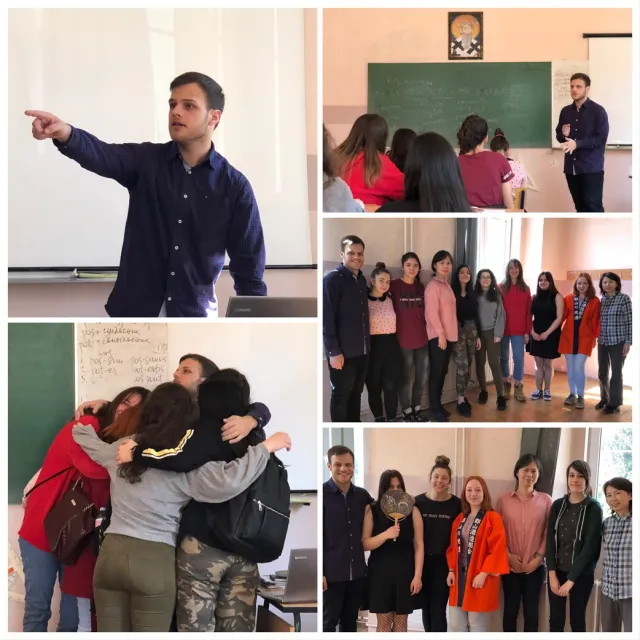
February Activity Report
28 February 2019
Global Japan Office Coordinator
AMARI Mino
In February, the days gradually became warmer in Serbia. It seems to hardly snow at all now. I’ve been told that it snowed a lot this year, but when I arrived in October I was under the impression it would snow even more, so I have been okay with this amount of snow.
◆The New Semester
Two sets of end-of-semester exams were held in early February, after which the new semester promptly began on February 18. Classes for this semester will be held from February until May, which will be followed by four sets of exams from June to September. This way the semesters flow here is very different from Japanese universities, so my sense of semesters has gradually shifted.
High schools in Belgrade were closed this month due to influenza, but luckily this doesn’t seem to have spread to the university, and the students are all coming to class in good health.
◆Club Activities Have Taken Off
Last semester, the new academic year had only just begun, so club activities were not very successful. Despite this, we were able to hold a few meetings of the Pera Pera Café and the calligraphy club, and since the new semester began, many students have been saying they want to do more club activities. I think that this is largely due to the efforts of the Japanese international students, especially the ones from TUFS. Professor TAKAHASHI Wataru, a visiting scholar form Japan, has also contributed to this rise in interest with his Extensive Reading Seminar.
◆Professor Takahashi’s Extensive Reading Seminar a Great Success
Professor Takahashi Wataru is a former Japanese language teacher at both TUFS and the University of Belgrade, and is currently teaching at the Kanda University of International Studies. He comes to the University of Belgrade every year to do research and run the Extensive Reading Seminar. This year, the seminar was held on February 25 alongside the meeting of the Book Club.
Last semester, the conversation-focused Pera Pera Café was popular, but after receiving proper guidance and tips for extensive reading from Professor Takahashi, the Book Club has gained more popularity. This year, it took a while for students to get into the Book Club’s activities, but the funny thing about books is that, once you realize how interesting they can be, you become addicted to them. Both first and second years have been actively participating in the Book Club, and I expect our activities will be quite lively from now on.
◆Club Opportunities
For Japanese university students, club and circle activities are an everyday occurrence, but in Serbian universities, clubs aren’t really a thing to begin with. Because of this, the clubs at the University of Belgrade are quite a novelty. In particular, the Pera Pera Café is a precious opportunity for Japanese language learners to talk about whatever they want with native Japanese speakers. I invite as many guests as I can each time, which is a good stimulus for students. For those reading this report, you are more than welcome to join in as a guest in our club activities at the University of Belgrade.
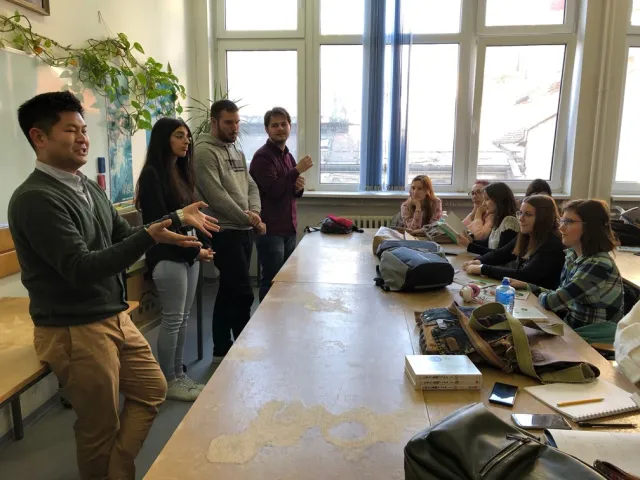
January Activity Report
31 January 2019
Global Japan Office Coordinator
AMARI Mino
Christmas and the New Year are actually celebrated twice in Serbia. They celebrate once on December 25 and January 1 like we do in Japan, and then once more on January 7 and January 14, which respectively are Christmas and the New Year according to the Julian Calendar. This means three weeks of continuous celebrations, so the city was very festive and, despite it being cold, perfect for leisurely strolls.
◆End-of-semester exams
The biggest hurdle for my students this month was the end-of-semester examinations.
Let me tell you a little bit about the exam… culture? here at the University of Belgrade.
First, students have to register for the exams they wish to sit for each subject, and then they have to pay to sit them. The fees themselves aren’t very expensive, but don’t you think that having to spend money to sit exams motivates the students?
In addition to this, these exams are not a “one chance” deal. Students actually have multiple chances to sit each exam. The earliest chances they have are once in January and once in February. They can sit an exam just once, or they can sit it both times. Their highest mark is used in their final grade. They can also take the final exams from the previous semester.
You’re probably thinking how nice it is that they can take exams as many times as they like. However, sitting an exam multiple times also means dealing with the challenging content several times. The students are quite serious when it comes to exams, as their grades can affect many aspects of their lives such as whether or not they can go on exchange, and room assignments in the dormitory.
While these exams are of course stressful for the students, they are also stressful for the teachers who have to prepare and mark them. However, I always love a good challenge.
◆New Year’s Celebration
It wasn’t a university event, but a New Year’s celebration was held at the Japanese Ambassador’s Residence. There are only a small number of Japanese nationals living in Serbia. Apparently less than 200. 80 of these Japanese nationals attended this New Year’s celebration, and deepened friendships while relishing delicious Japanese food. Only three months have passed since I came to Serbia, so it was my first time meeting most of these people. I met all kinds of people, including senior volunteers from JICA, so it was a very fun and rewarding evening.
◆End-of-semester Farewells
The academic year and semester that began last October came to an end at the end of this month. The final exams are not quite over yet, but the next semester will begin in late February.
Due to this, some international students will be returning to their countries, and some new ones will be coming to Serbia. One student was to return to Japan at the end of January, so we held a farewell party during club activities.
I was really impressed by this student, a TUFS student, who took initiative during the party to lead a toast, which enlivened all the Serbian students and made the party a great success. We also invited some Japanese people from outside of the university, so the party was really enjoyable.
In February, new exchange students will arrive from TUFS. I hope to support them in my role as the GJO coordinator so they can enjoy their study abroad experience in Serbia.
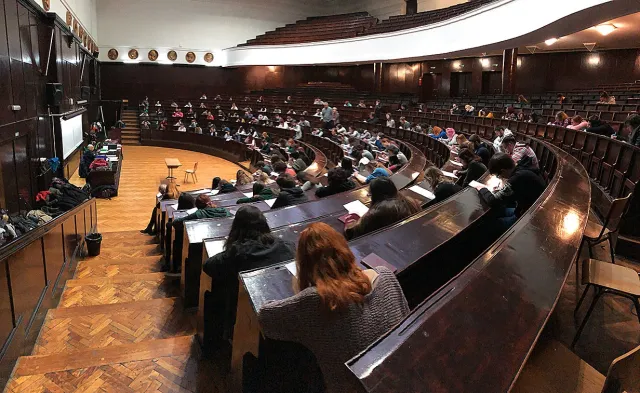
December Activity Report
31 December 2018
Global Japan Office Coordinator
AMARI Mino
December in Belgrade, in preparation for Christmas and the New Year, is aesthetically the most splendid month. Serbian Christmas follows the Julian Calendar and is celebrated on January 7, so it feels like Christmas lasts all throughout the New Year period. It snowed heavily in mid-December, but disappeared around the New Year, which was welcomed with comparatively warm weather.
◆Colloquium (Mid-term Exams)
The biggest concern for my students this month was whether or not they could pass the colloquiums. Heading into December, colloquiums are held in many subjects, and students have been living very busy lives preparing assignments and presentations for these colloquiums week after week.
The Japanese colloquium was held for all students from first to fourth year simultaneously on December 15. Since there were so many students, it took more effort than usual to seat them all appropriately. Us teachers are all wracking our brains to think of better ways to hold these exams in the future.
◆Club Activities
In the midst of this busy month, it was unfortunately too difficult to hold club activities, so the students made a poll, of their own volition, which we are using to decide when to meet. While we wanted to hold more club activities, the students just didn’t have time due to their busy schedules, but, together with the students, us supporting teachers are focusing our efforts on devising time to continue club activities.
◆Noh Theatre Workshop
Professional Noh performer Mr. SAKURAMA Ujin visited Belgrade for a performance, and was invited by Professor YAMAZAKI Kayoko to hold a workshop on Noh theatre. The students shined in this workshop, which was actually a workshop you can’t commonly experience in Japan. They actively asked many questions, and thoroughly enjoyed the workshop.
◆Upperclassmen’s gift to their lowerclassmen
Getting closer to Christmas, hoping it would make class a little more fun, students from my upper year-level classes decorated the GJO classroom. This was all done in the spirit of volunteering, and the students all contributed a little money and worked on the decorations together. One day, I came to the classroom, which was decorated as a surprise, and when I entered all the Christmas lights turned on. I was surprised, and so were the first-year students, who were very happy with their upperclassmen’s efforts. Through this, the relationship between the year-groups grew deeper, and perhaps now we could do some teambuilding with all the students without these year-level hierarchies.
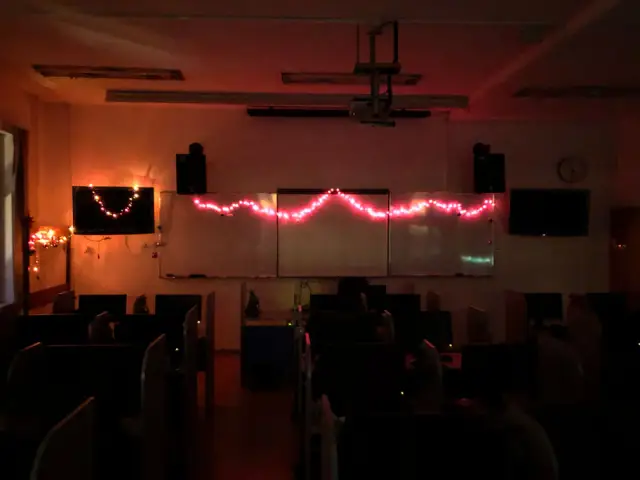
November Activity Report
30 November 2018
Global Japan Office Coordinator
AMARI Mino
November in Belgrade suddenly became cold halfway through, and it snowed twice, so I definitely think an all-out winter is coming. Decorations have gone up around the city in preparation for Christmas, and the main street near the Faculty of Philology’s campus is particularly beautiful, entertaining the eyes of many locals and tourists.
◆Start of Club Activities
To make up for things we can’t cover in class, the Japanese department here at the University of Belgrade has taken a page from Japanese club culture and established a calligraphy club, a conversation club called the Pera Pera Café, and a book club. At the University of Belgrade, where club activities and cultural festivals do not exist like they do in Japanese universities, club activities exist as a kind of special extra-curricular activity.
During the semester, everyone is busy with classes and exams, so it is hard for students to gather for club activities. Despite this, the students are making time in their busy schedules, and club activities are being held. The third-year students take on leadership roles, and independently run the clubs. Japanese students and teachers, like myself, also actively participate, making each club an irreplaceable opportunity for cultural exchange with Japan.
In November the calligraphy club met once, and the Pera Pera Café met twice. Since the calligraphy club met on Armistice Day, which this year happened to celebrate its 100th anniversary, we couldn’t use the classrooms on campus. Instead, we borrowed space at a local café and did water calligraphy.
Serbian students love kanji. They are challenging themselves with many kanji every day, all while saying “kanji is hard, but also fun!” Many students are attracted by kanji as an art form, so giving them opportunities to express kanji through calligraphy is very important. While some of my students are shy during class, they actively churn out calligraphy pieces one after another during club activities. Watching them do so makes me very happy.
The Pera Pera Café is another popular club. Freely discussing a wide range of topics while drinking nice coffee in a café is something special that you definitely can’t do in the classroom. Even if students can’t speak Japanese fluently, I think that if they participate regularly they will pick up new words and realize the joy that comes from learning these. This year, even first-year students are participating, and I think we can expect a lot of excitement towards upcoming activities.
When club activities ended for the day, without us realizing it, it was already dark out. On these days, it becomes very cold at night, but the students headed home with warmth in their hearts.
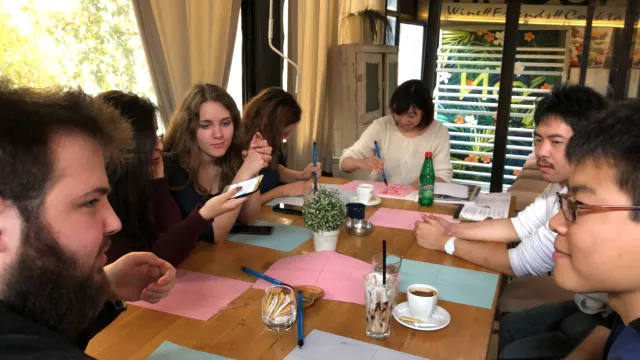
October Activity Report
31 October 2018
Global Japan Office Coordinator
AMARI Mino
On October 2 I took over the position of GJO coordinator at the University of Belgrade. Before this, the University held its Entrance Ceremony on October 1 and welcomed its new students to the new academic year. October in Belgrade was generally warm and pleasant, and the climate allowed everyone to fully enjoy fall.
◆72 new students in the Japanese department
This year, 72 students registered to major in Japanese in the Faculty of Philology’s Japanese Language, Literature and Culture Department. The University of Belgrade doesn’t do definitive course registration at the start of the semester like at TUFS, so the final number of students is determined by the number of students who sit the end-of-semester exams.
Until now, it seemed that less students were continuing to study Japanese as they progressed through their degrees, but recently this trend has changed, and more students are sticking with Japanese until the end. Because of this, when you combine the registers of all four year groups together, over 300 students are majoring in Japanese. Since there are many students who stick with Japanese despite failing a year, the number of students actually increases with each year level. In addition to the number of registered students, the number of students actually attending classes is also rising.
Alongside this exciting increase in Japanese language learners, the following problems have arisen.
①72 Students in a class made for 36
The classroom that doubles as the Global Japan Office is fitted with computers and materials gifted from Japan, and can fit up to 36 students inside. In this room, 72 first-year students are simultaneously learning Japanese. I had no choice but to line up extra chairs along the walls and at the back of the classroom for students to sit on. On top of this, there is only one teacher for these 72 students. Naturally I wanted to split the students into several smaller classes, but there are not enough classrooms at the university to do this, so splitting them up is not an option.
If the number of students increases any more than this, there won’t be enough Japanese teachers to handle them. For the tests that affect the students’ final grades, I have been splitting the class in two, with one half waiting in the hallway while the other group sits the test.
②Aging materials
The GJO Classroom has 36 computers for student use, and one for staff use. There are also two projectors. Despite this, we generally only use the staff computer and one projector.
③Exchange opportunities
With the increase in students, I also want to increase the number of students who can study abroad in Japan, but the actual number of exchange opportunities is not increasing. Since private exchanges are quite complicated, students are craving for more exchange programs and scholarship-funded programs. Even though this many students chose to study Japanese, and are highly motivated to do so, if there are no opportunities for them to actually go to Japan, they will lose their motivation. I hope to work towards solving these issues.
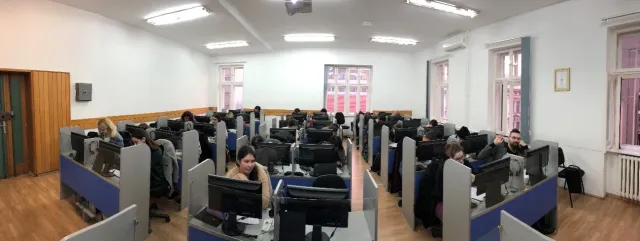
September Activity Report
30 September 2018
Global Japan Office Coordinator
MASAKI Miyu
September was a month of extreme temperature differences. The summer heat had temperatures up around 30 degrees until the latter end of the month, then after about three autumn-like days, the temperatures suddenly dropped to winter levels, with some days having lows of 5 degrees, despite it still being September.
【Last Exam of the AcademicYear】
We held two exams every other week. With the last of these, exams for the current academic year came to an end. Even if students fail these exams, they can take the subject again next year, but many students study hard so they can pass the first time, and so I think that’s why the pass rate was high.
【 “Pera-Pera Café” Last Club Activities】
Before the start of the new semester in October, students started to return to Belgrade, so I held a meeting of the Japanese conversation club, “Pera-Pera Café”. There is also a calligraphy club and a book club. These clubs also serve as places where local students can meet Japanese exchange students.
【At Our Usual Spot】
This was our last meeting before I leave, so we took a photo to commemorate the occasion. Belgrade is so different to Tokyo, and while I was taken aback by some things, it was a very fun place to be. It has been two and a half years since I took over this position at the GJO, and I was able to thoroughly enjoy it thanks to my students.
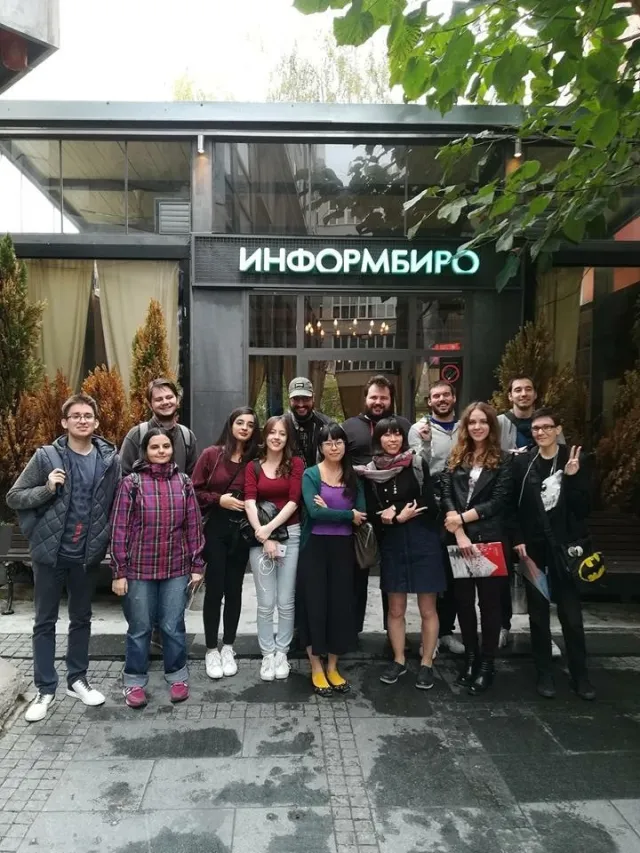
August Activity Report
31 August 2018
Global Japan Office Coordinator
MASAKI Miyu
August was a hot month. However, it was quite cool in the shade and at night. Japan experienced a heat wave this summer, but since Belgrade is not as humid, it is easier to be here even if the temperature is the same.
【Visitors from Japan】
One hot day, Professor NAKAJIMA Takafumi from Gakushuin Women’s College, who conducts research on Central and Eastern Europe, and his seminar students visited the University of Belgrade and met with our Japanese department students.
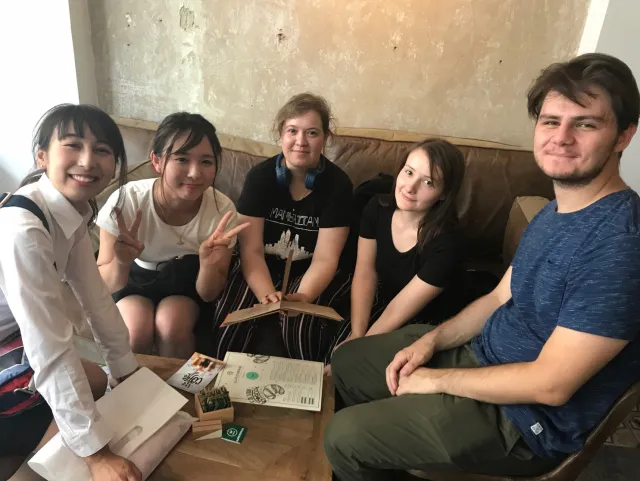
It was a fine day, so we walked around the fortress at Kalemegdan Park, after which we stopped in a café on the main street to escape the heat.
Japanese department students from first to fourth year came with us and seemed to be enjoying talking with the Japanese university students. While Serbian students are usually shy and don’t want to talk so much, on this day they were actively guiding the Nakajima seminar students around the city.
I am very grateful to Professor Nakajima and his seminar students for stopping by Belgrade every year during their field work.
July Activity Report
31 July 2018
Global Japan Office Coordinator
MASAKI Miyu
The rainy June came to an end, and now it is July. July is still raining on and off, but it is better than last month as the rain usually only lasts for a few hours instead of all day.
【Ispit (Second round of exams)】
The second round (out of five) of final exams for the end of the academic year were held this month. Last month’s exam had a bigger turnout, as always, so there should be less people sitting exams from now on. However, there wasn’t a big difference in the number of students sitting exams for June and July. Marking this month’s exams also took me all day even though I started at 8am.
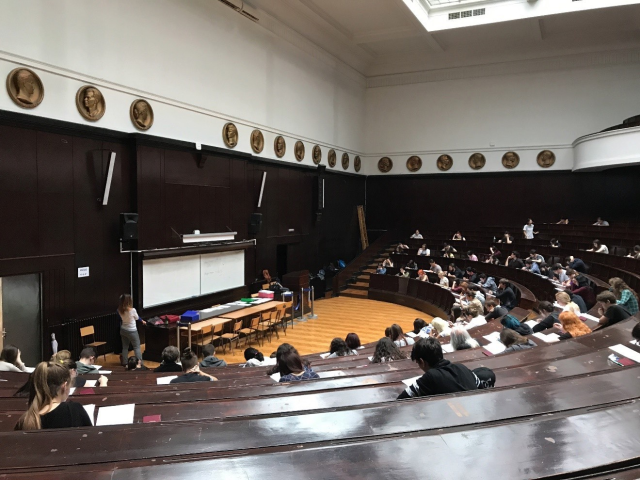
The exams for the main subjects were held simultaneously for all year-groups in a large hall. There are many rules about seating in place to prevent cheating, and we do have a hard time getting all the students to sit.
【Japanizam2018】
In recent years, events showcasing Japanese culture and anime/manga, such as America’s Comic-con and France’s Japonismes, have been held in many countries, and even in Belgrade we have Japanizam, which is held every year in July attracting quite the turnout. Japanizam is held over a few days that are jam-packed with booths selling anime goods (figurines, badges, etc.), cosplay competitions, film screenings, talks on various topics, appearances by voice actors invited from Japan, and other events. Japanizam is held inside an event center in the city, and the inside of the venue is just as hot as the summer sun outside.
This event is run by a volunteer association called Sakurabana, which some of my students belong to. When I went to see them at the event, they looked very busy working away.
June Activity Report
30 June 2018
Global Japan Office Coordinator
MASAKI Miyu
It is now June.
For some reason, this year, there have been many weeks where the rain never seems to stop. Japan has a rainy season, and it seems Belgrade is following suit, as this month was particularly rainy. At the start of the month, some days were hot enough to be August, but when it started raining the temperature dropped instantly. While before I was sweating from walking around in shorts and a tank top, this week it’s too cold to go out without wearing pants and long sleeves.
【Ispit (First round of exams)】
The first round (out of five) of final exams for the end of the academic year were held this month. All students will sit the Japanese writing exam simultaneously, so I held the exam in a large hall instead of the usual classroom.
The students can sit the exam during any of the five rounds, as many times as they like, but most students come to the first round in June right after classes finish. Marking their tests was a challenge… I started at 8am and they took me all day.
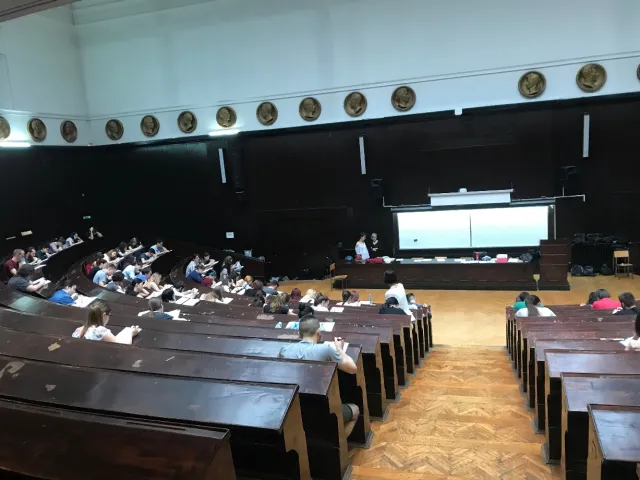
The main exams for Japanese are kanji, grammar, Modern Japanese (general subject), translation and literature. The grammar exam usually has students answer Japanese grammar terms in Serbian. The Modern Japanese exam is a written exam, and since it’s a general subject its questions cover everything from vocabulary to reading comprehension, making it a bit harder to study for. The kanji exam is a revision of the year’s class content, so studying for it is easy, but there is quite a lot of content to cover, so it does take a while. The translation exam is exactly how it sounds, a translation exam from Japanese into Serbian and vice versa, and the literature exam is the only oral exam.
As I wrote above, students can take the exams whenever and however many times, so many students sit their compulsory exams several times. However, if they finish everything in June, they have nothing to do until the next semester starts in October. The summer break is long. While this system is good for the students, it requires a lot of effort form the teachers.
May Activity Report
31 May 2018
Global Japan Office Coordinator
MASAKI Miyu
It’s May! The city is glistening with greenery.
I still catch myself thinking “nature is so beautiful” during the day. Going into summer, it’s a bit hot to be hanging around and thinking this.
Unlike Japan, people in Serbia always try to tan their skin as much as they can. “Your skin is so fair!” is not a compliment at all (apparently “your face is so small” is also not a compliment, as everyone has small faces here).
【Prvi Maj (Labor Day)】
May starts with a holiday. In Japan we have Labor Thanksgiving Day, and in Serbia a similar holiday falls on May 1. On this day, many people have barbeques in parks and forests. It seems to be a day for enjoying nature.
【Završni Čas (Final Presentation)】
Since this month was the last month of the current academic year, the annual presentation was held on the 22nd. This presentation directly translates to “Final Class” from Serbian, but there will still some classes right up until the 31st. At the final presentation, each year group has to present something, so this year’s first-year students performed songs and recited poetry, and the second to fourth years made and submitted videos. I am leaving at the end of September, and so some of the students gave me farewell gifts after their presentations.
The advanced students made videos about scenarios that use the word “of course” in Japanese, and made them into a documentary-like series. The second-year students made a video of stills about the tanka and haiku they learnt in their literature class, and the third-years made a video walking around the city to the Japanese song “Ai ni Ikanakya”, or “I must go and see you” (I don’t know whose song this is). At the end of this video, some students entered the venue and surprised me with a present. The fourth-year students will be graduating this year, so they made a video interviewing their classmates on what they were going to do after graduating (the joke being that no one had any plans). Everyone was in high spirits after this video. It’s finally the end of the academic year. The students all worked hard together for their final exams.
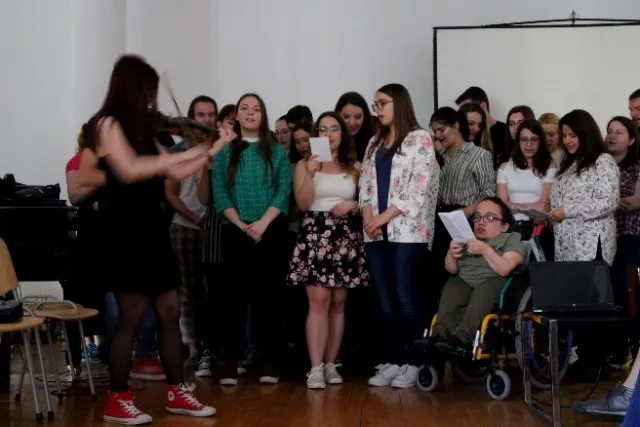
April Activity Report
2 May 2018
Global Japan Office Coordinator
MASAKI Miyu
We have been experiencing a drought here in Belgrade, so it was just like summer.
During the day the temperature rises to over 25 degrees, and I haven’t seen anyone wearing long sleeve shirts. However, it is still cool during the morning and night. Come June and July, and air conditioning becomes a necessity, so the heat is bearable right now.
【Easter Break】
At the start of April, we had a break for Easter. Devout Christians abstain from eating meat before Easter. This ends on Easter Sunday (the Sunday that falls in the week of Easter). The day before Easter Sunday, all the eggs and meat disappear from the supermarkets. Just like in other Christian countries, in Serbia, people dye eggs with onion skin, and use dyes to paint them. On top of that, people play egg tapping (a Serbian tradition). The egg that lasts the longest is said to protect your household for a year. I received painted eggs from my students. I think I will place it in my room as a good luck charm.
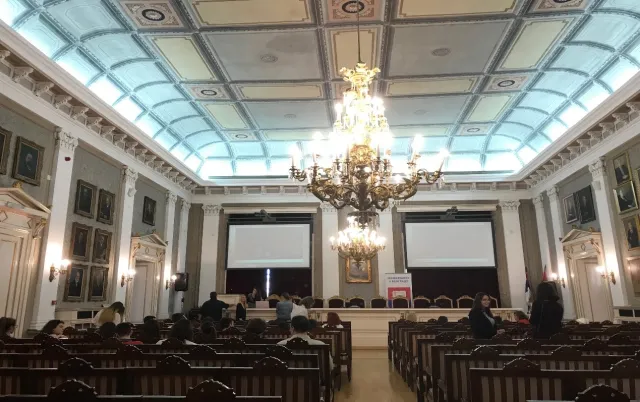
【Japanese Promotion Project Closing Ceremony
The closing ceremony for the “Japanese Promotion Project”, a collaborative project between the embassy and Mitsubishi Corporation, was held. Since there were many participating schools this year, there were over 180 participants, including students, guardians and faculty, making for a lively gathering. Speeches were given by Ambassador Maruyama from the embassy, and Mr. Tsukada, the General Manager of the Mitsubishi Corporation Belgrade Liaison Office. Programs made by the students were also handed out.
After the ceremony, it was entertaining to see so many students run over to take photos with Ambassador Maruyama and Mr. Tsukada.
